401021 - Professional Nursing: Transition Case Study Analysis
VerifiedAdded on 2023/06/03
|10
|2420
|238
Essay
AI Summary
This essay critically analyzes the transition from an academic nursing environment to professional practice, focusing on the challenges faced by new graduates. It discusses the importance of a healthy transition for building confidence and ensuring a positive professional environment, highlighting obstacles such as bridging the theory-practice gap, managing workload, and working with multidisciplinary teams. The essay also explores strategies like mentorship programs, reflection-based experiences, and skill acquisition models (e.g., the Dreyfus model) to facilitate a smoother transition. The author reflects on their own experiences and emphasizes the importance of support from supervisors and seniors in easing the workload and promoting positive employee engagement. The conclusion underscores the significance of addressing the challenges in this transition to prevent attrition and ensure the successful transformation of student nurses into competent professionals.
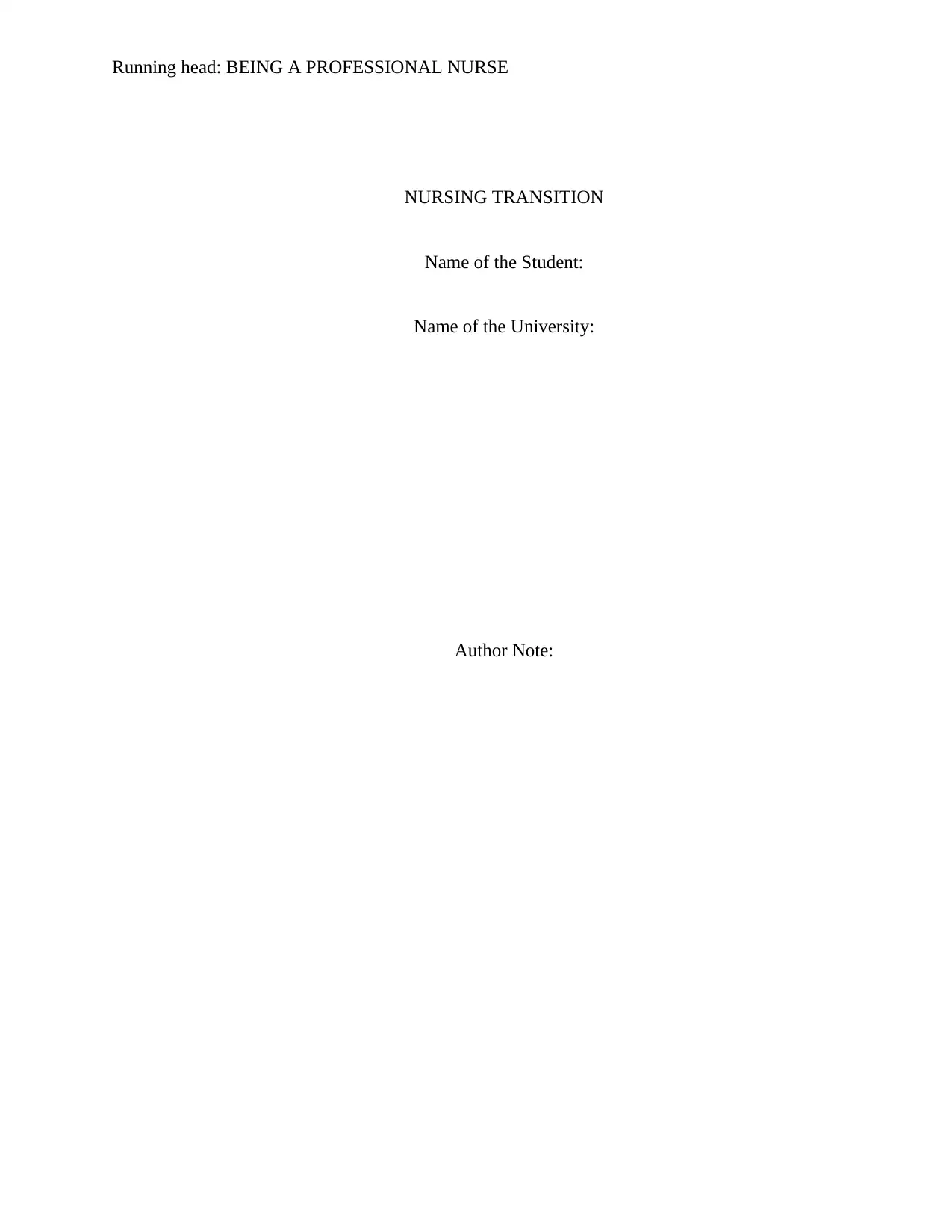
Running head: BEING A PROFESSIONAL NURSE
NURSING TRANSITION
Name of the Student:
Name of the University:
Author Note:
NURSING TRANSITION
Name of the Student:
Name of the University:
Author Note:
Paraphrase This Document
Need a fresh take? Get an instant paraphrase of this document with our AI Paraphraser
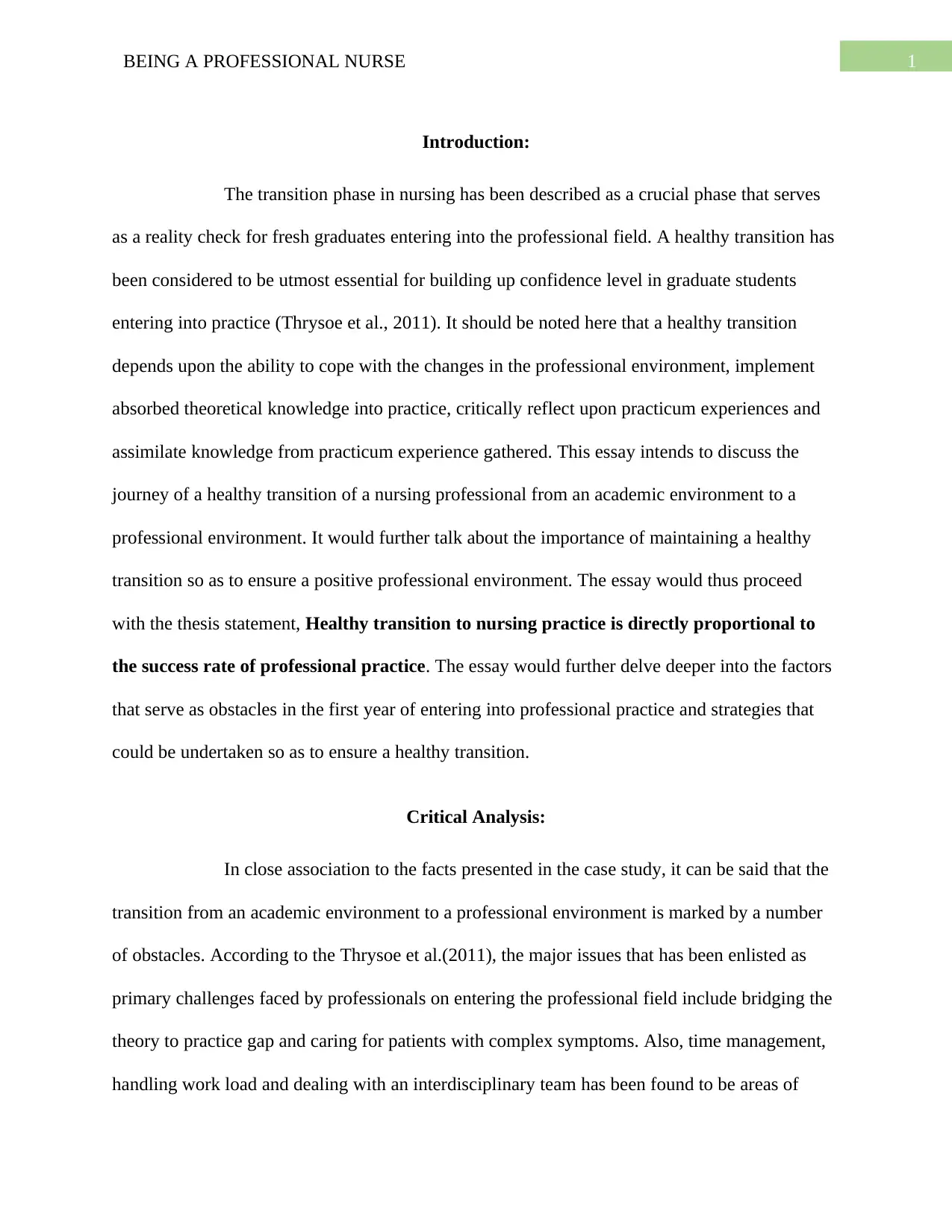
1BEING A PROFESSIONAL NURSE
Introduction:
The transition phase in nursing has been described as a crucial phase that serves
as a reality check for fresh graduates entering into the professional field. A healthy transition has
been considered to be utmost essential for building up confidence level in graduate students
entering into practice (Thrysoe et al., 2011). It should be noted here that a healthy transition
depends upon the ability to cope with the changes in the professional environment, implement
absorbed theoretical knowledge into practice, critically reflect upon practicum experiences and
assimilate knowledge from practicum experience gathered. This essay intends to discuss the
journey of a healthy transition of a nursing professional from an academic environment to a
professional environment. It would further talk about the importance of maintaining a healthy
transition so as to ensure a positive professional environment. The essay would thus proceed
with the thesis statement, Healthy transition to nursing practice is directly proportional to
the success rate of professional practice. The essay would further delve deeper into the factors
that serve as obstacles in the first year of entering into professional practice and strategies that
could be undertaken so as to ensure a healthy transition.
Critical Analysis:
In close association to the facts presented in the case study, it can be said that the
transition from an academic environment to a professional environment is marked by a number
of obstacles. According to the Thrysoe et al.(2011), the major issues that has been enlisted as
primary challenges faced by professionals on entering the professional field include bridging the
theory to practice gap and caring for patients with complex symptoms. Also, time management,
handling work load and dealing with an interdisciplinary team has been found to be areas of
Introduction:
The transition phase in nursing has been described as a crucial phase that serves
as a reality check for fresh graduates entering into the professional field. A healthy transition has
been considered to be utmost essential for building up confidence level in graduate students
entering into practice (Thrysoe et al., 2011). It should be noted here that a healthy transition
depends upon the ability to cope with the changes in the professional environment, implement
absorbed theoretical knowledge into practice, critically reflect upon practicum experiences and
assimilate knowledge from practicum experience gathered. This essay intends to discuss the
journey of a healthy transition of a nursing professional from an academic environment to a
professional environment. It would further talk about the importance of maintaining a healthy
transition so as to ensure a positive professional environment. The essay would thus proceed
with the thesis statement, Healthy transition to nursing practice is directly proportional to
the success rate of professional practice. The essay would further delve deeper into the factors
that serve as obstacles in the first year of entering into professional practice and strategies that
could be undertaken so as to ensure a healthy transition.
Critical Analysis:
In close association to the facts presented in the case study, it can be said that the
transition from an academic environment to a professional environment is marked by a number
of obstacles. According to the Thrysoe et al.(2011), the major issues that has been enlisted as
primary challenges faced by professionals on entering the professional field include bridging the
theory to practice gap and caring for patients with complex symptoms. Also, time management,
handling work load and dealing with an interdisciplinary team has been found to be areas of
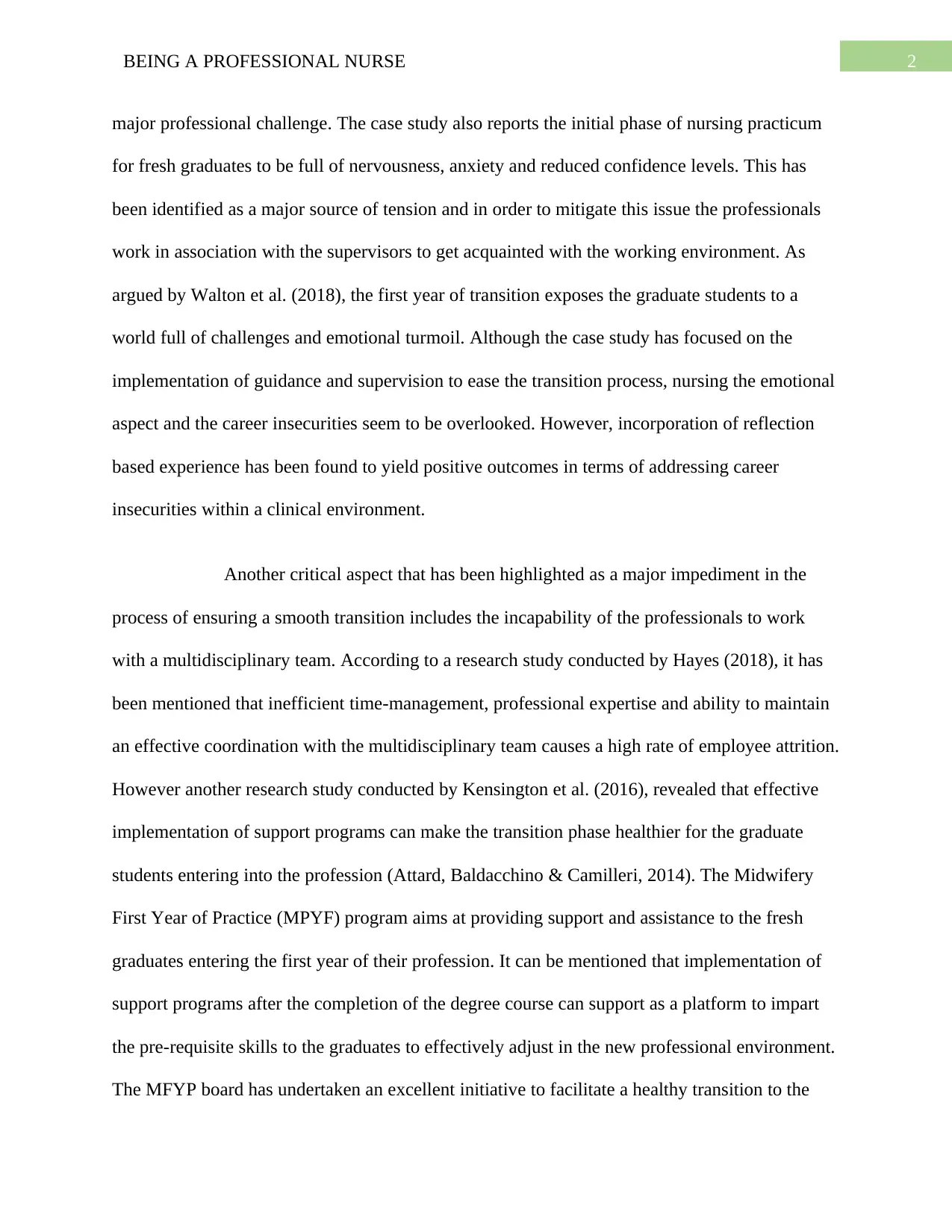
2BEING A PROFESSIONAL NURSE
major professional challenge. The case study also reports the initial phase of nursing practicum
for fresh graduates to be full of nervousness, anxiety and reduced confidence levels. This has
been identified as a major source of tension and in order to mitigate this issue the professionals
work in association with the supervisors to get acquainted with the working environment. As
argued by Walton et al. (2018), the first year of transition exposes the graduate students to a
world full of challenges and emotional turmoil. Although the case study has focused on the
implementation of guidance and supervision to ease the transition process, nursing the emotional
aspect and the career insecurities seem to be overlooked. However, incorporation of reflection
based experience has been found to yield positive outcomes in terms of addressing career
insecurities within a clinical environment.
Another critical aspect that has been highlighted as a major impediment in the
process of ensuring a smooth transition includes the incapability of the professionals to work
with a multidisciplinary team. According to a research study conducted by Hayes (2018), it has
been mentioned that inefficient time-management, professional expertise and ability to maintain
an effective coordination with the multidisciplinary team causes a high rate of employee attrition.
However another research study conducted by Kensington et al. (2016), revealed that effective
implementation of support programs can make the transition phase healthier for the graduate
students entering into the profession (Attard, Baldacchino & Camilleri, 2014). The Midwifery
First Year of Practice (MPYF) program aims at providing support and assistance to the fresh
graduates entering the first year of their profession. It can be mentioned that implementation of
support programs after the completion of the degree course can support as a platform to impart
the pre-requisite skills to the graduates to effectively adjust in the new professional environment.
The MFYP board has undertaken an excellent initiative to facilitate a healthy transition to the
major professional challenge. The case study also reports the initial phase of nursing practicum
for fresh graduates to be full of nervousness, anxiety and reduced confidence levels. This has
been identified as a major source of tension and in order to mitigate this issue the professionals
work in association with the supervisors to get acquainted with the working environment. As
argued by Walton et al. (2018), the first year of transition exposes the graduate students to a
world full of challenges and emotional turmoil. Although the case study has focused on the
implementation of guidance and supervision to ease the transition process, nursing the emotional
aspect and the career insecurities seem to be overlooked. However, incorporation of reflection
based experience has been found to yield positive outcomes in terms of addressing career
insecurities within a clinical environment.
Another critical aspect that has been highlighted as a major impediment in the
process of ensuring a smooth transition includes the incapability of the professionals to work
with a multidisciplinary team. According to a research study conducted by Hayes (2018), it has
been mentioned that inefficient time-management, professional expertise and ability to maintain
an effective coordination with the multidisciplinary team causes a high rate of employee attrition.
However another research study conducted by Kensington et al. (2016), revealed that effective
implementation of support programs can make the transition phase healthier for the graduate
students entering into the profession (Attard, Baldacchino & Camilleri, 2014). The Midwifery
First Year of Practice (MPYF) program aims at providing support and assistance to the fresh
graduates entering the first year of their profession. It can be mentioned that implementation of
support programs after the completion of the degree course can support as a platform to impart
the pre-requisite skills to the graduates to effectively adjust in the new professional environment.
The MFYP board has undertaken an excellent initiative to facilitate a healthy transition to the
⊘ This is a preview!⊘
Do you want full access?
Subscribe today to unlock all pages.

Trusted by 1+ million students worldwide
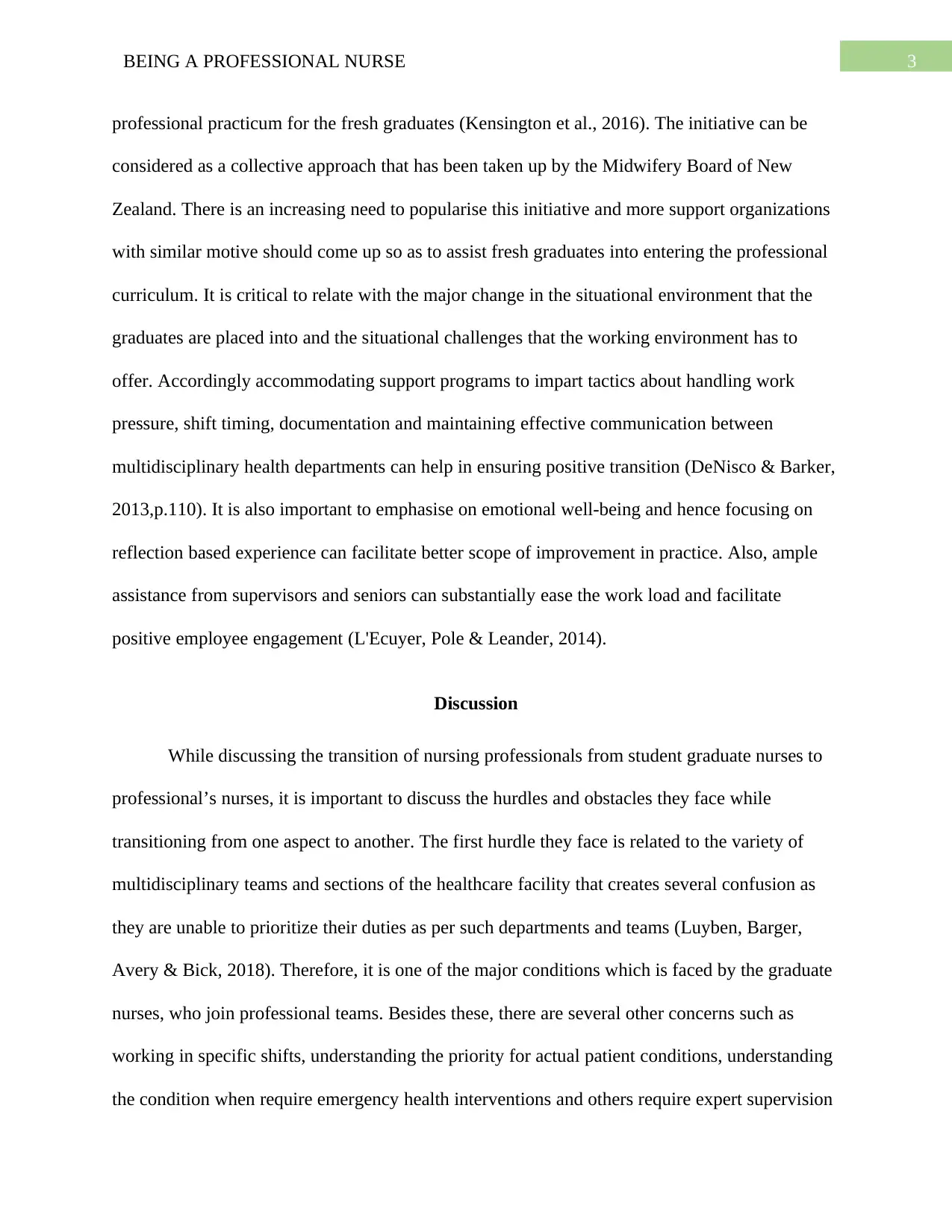
3BEING A PROFESSIONAL NURSE
professional practicum for the fresh graduates (Kensington et al., 2016). The initiative can be
considered as a collective approach that has been taken up by the Midwifery Board of New
Zealand. There is an increasing need to popularise this initiative and more support organizations
with similar motive should come up so as to assist fresh graduates into entering the professional
curriculum. It is critical to relate with the major change in the situational environment that the
graduates are placed into and the situational challenges that the working environment has to
offer. Accordingly accommodating support programs to impart tactics about handling work
pressure, shift timing, documentation and maintaining effective communication between
multidisciplinary health departments can help in ensuring positive transition (DeNisco & Barker,
2013,p.110). It is also important to emphasise on emotional well-being and hence focusing on
reflection based experience can facilitate better scope of improvement in practice. Also, ample
assistance from supervisors and seniors can substantially ease the work load and facilitate
positive employee engagement (L'Ecuyer, Pole & Leander, 2014).
Discussion
While discussing the transition of nursing professionals from student graduate nurses to
professional’s nurses, it is important to discuss the hurdles and obstacles they face while
transitioning from one aspect to another. The first hurdle they face is related to the variety of
multidisciplinary teams and sections of the healthcare facility that creates several confusion as
they are unable to prioritize their duties as per such departments and teams (Luyben, Barger,
Avery & Bick, 2018). Therefore, it is one of the major conditions which is faced by the graduate
nurses, who join professional teams. Besides these, there are several other concerns such as
working in specific shifts, understanding the priority for actual patient conditions, understanding
the condition when require emergency health interventions and others require expert supervision
professional practicum for the fresh graduates (Kensington et al., 2016). The initiative can be
considered as a collective approach that has been taken up by the Midwifery Board of New
Zealand. There is an increasing need to popularise this initiative and more support organizations
with similar motive should come up so as to assist fresh graduates into entering the professional
curriculum. It is critical to relate with the major change in the situational environment that the
graduates are placed into and the situational challenges that the working environment has to
offer. Accordingly accommodating support programs to impart tactics about handling work
pressure, shift timing, documentation and maintaining effective communication between
multidisciplinary health departments can help in ensuring positive transition (DeNisco & Barker,
2013,p.110). It is also important to emphasise on emotional well-being and hence focusing on
reflection based experience can facilitate better scope of improvement in practice. Also, ample
assistance from supervisors and seniors can substantially ease the work load and facilitate
positive employee engagement (L'Ecuyer, Pole & Leander, 2014).
Discussion
While discussing the transition of nursing professionals from student graduate nurses to
professional’s nurses, it is important to discuss the hurdles and obstacles they face while
transitioning from one aspect to another. The first hurdle they face is related to the variety of
multidisciplinary teams and sections of the healthcare facility that creates several confusion as
they are unable to prioritize their duties as per such departments and teams (Luyben, Barger,
Avery & Bick, 2018). Therefore, it is one of the major conditions which is faced by the graduate
nurses, who join professional teams. Besides these, there are several other concerns such as
working in specific shifts, understanding the priority for actual patient conditions, understanding
the condition when require emergency health interventions and others require expert supervision
Paraphrase This Document
Need a fresh take? Get an instant paraphrase of this document with our AI Paraphraser
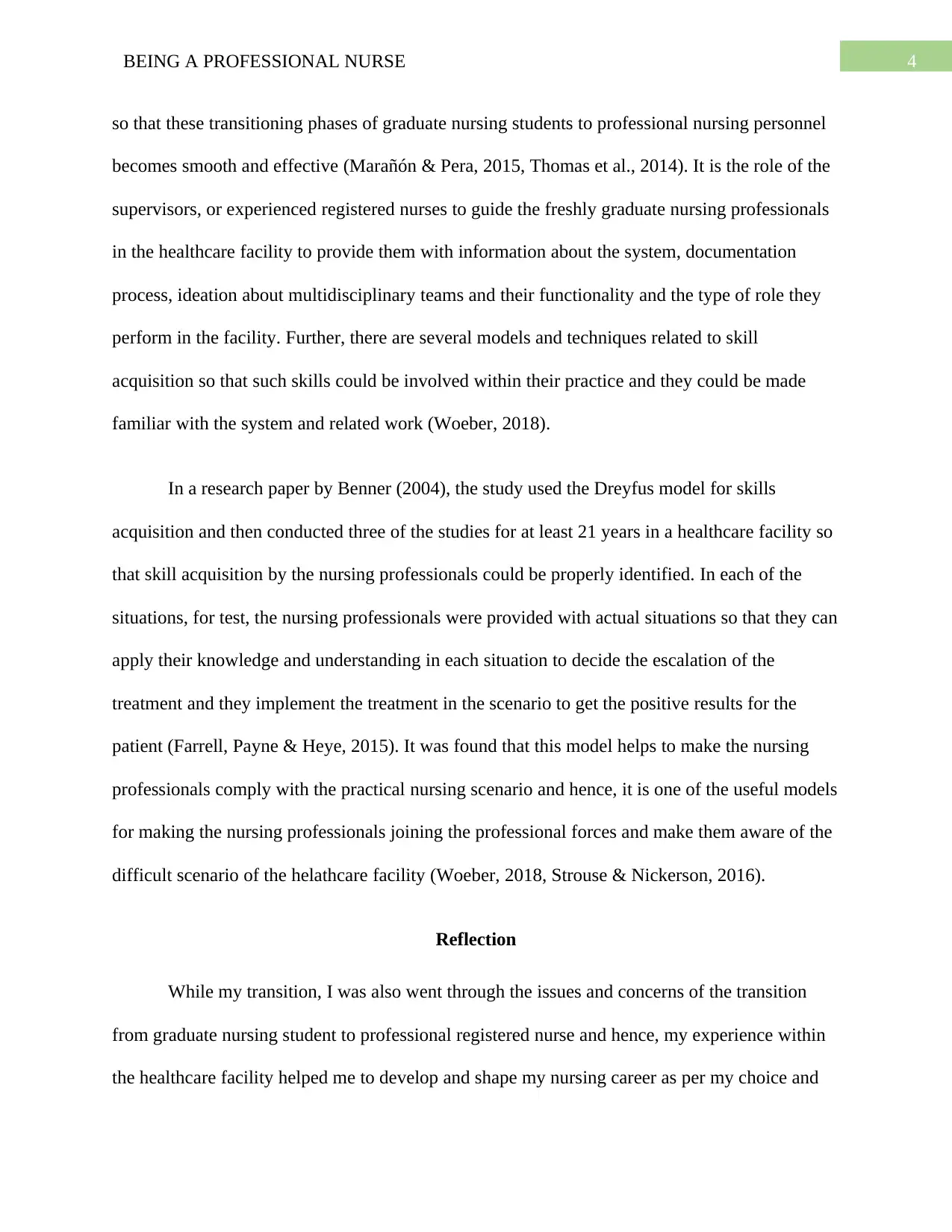
4BEING A PROFESSIONAL NURSE
so that these transitioning phases of graduate nursing students to professional nursing personnel
becomes smooth and effective (Marañón & Pera, 2015, Thomas et al., 2014). It is the role of the
supervisors, or experienced registered nurses to guide the freshly graduate nursing professionals
in the healthcare facility to provide them with information about the system, documentation
process, ideation about multidisciplinary teams and their functionality and the type of role they
perform in the facility. Further, there are several models and techniques related to skill
acquisition so that such skills could be involved within their practice and they could be made
familiar with the system and related work (Woeber, 2018).
In a research paper by Benner (2004), the study used the Dreyfus model for skills
acquisition and then conducted three of the studies for at least 21 years in a healthcare facility so
that skill acquisition by the nursing professionals could be properly identified. In each of the
situations, for test, the nursing professionals were provided with actual situations so that they can
apply their knowledge and understanding in each situation to decide the escalation of the
treatment and they implement the treatment in the scenario to get the positive results for the
patient (Farrell, Payne & Heye, 2015). It was found that this model helps to make the nursing
professionals comply with the practical nursing scenario and hence, it is one of the useful models
for making the nursing professionals joining the professional forces and make them aware of the
difficult scenario of the helathcare facility (Woeber, 2018, Strouse & Nickerson, 2016).
Reflection
While my transition, I was also went through the issues and concerns of the transition
from graduate nursing student to professional registered nurse and hence, my experience within
the healthcare facility helped me to develop and shape my nursing career as per my choice and
so that these transitioning phases of graduate nursing students to professional nursing personnel
becomes smooth and effective (Marañón & Pera, 2015, Thomas et al., 2014). It is the role of the
supervisors, or experienced registered nurses to guide the freshly graduate nursing professionals
in the healthcare facility to provide them with information about the system, documentation
process, ideation about multidisciplinary teams and their functionality and the type of role they
perform in the facility. Further, there are several models and techniques related to skill
acquisition so that such skills could be involved within their practice and they could be made
familiar with the system and related work (Woeber, 2018).
In a research paper by Benner (2004), the study used the Dreyfus model for skills
acquisition and then conducted three of the studies for at least 21 years in a healthcare facility so
that skill acquisition by the nursing professionals could be properly identified. In each of the
situations, for test, the nursing professionals were provided with actual situations so that they can
apply their knowledge and understanding in each situation to decide the escalation of the
treatment and they implement the treatment in the scenario to get the positive results for the
patient (Farrell, Payne & Heye, 2015). It was found that this model helps to make the nursing
professionals comply with the practical nursing scenario and hence, it is one of the useful models
for making the nursing professionals joining the professional forces and make them aware of the
difficult scenario of the helathcare facility (Woeber, 2018, Strouse & Nickerson, 2016).
Reflection
While my transition, I was also went through the issues and concerns of the transition
from graduate nursing student to professional registered nurse and hence, my experience within
the healthcare facility helped me to develop and shape my nursing career as per my choice and
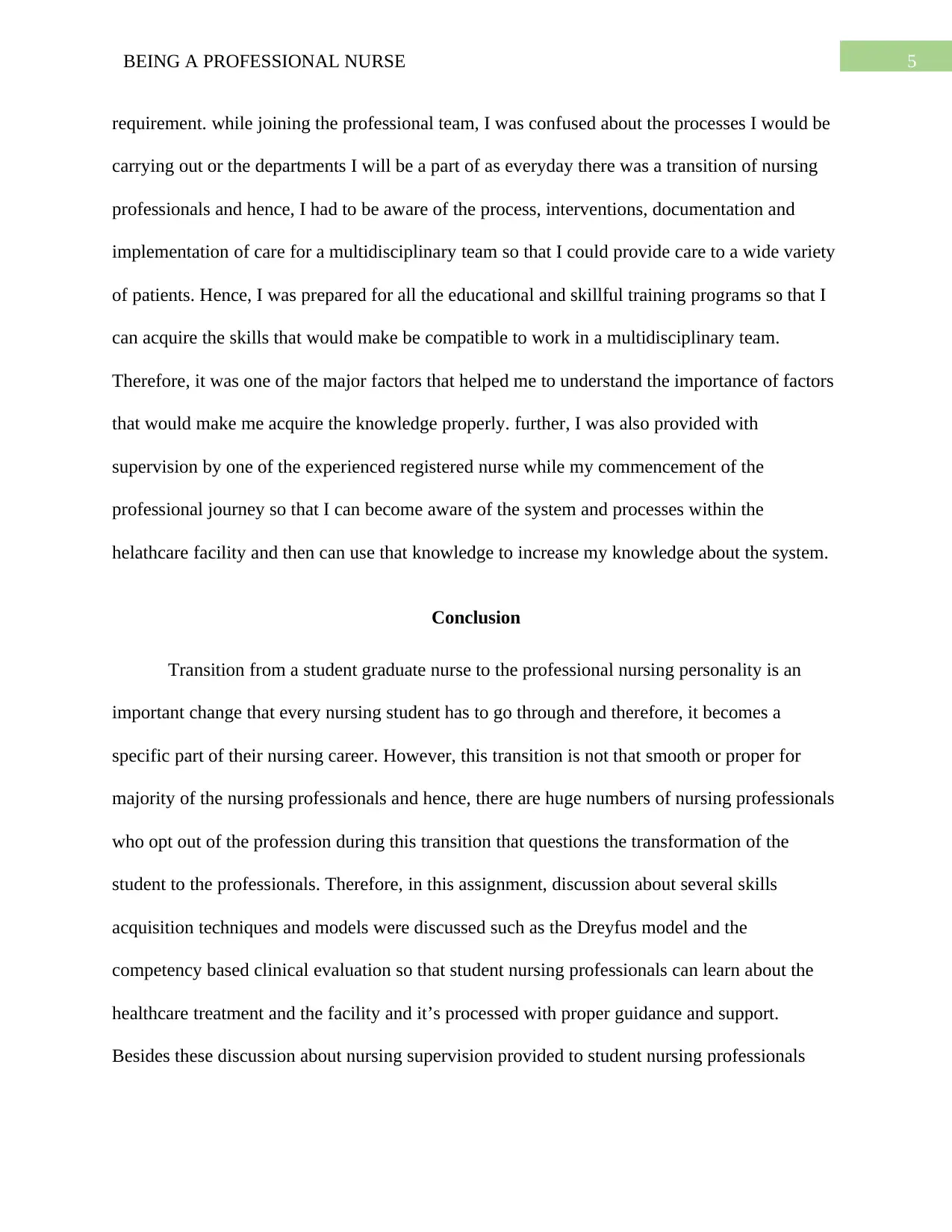
5BEING A PROFESSIONAL NURSE
requirement. while joining the professional team, I was confused about the processes I would be
carrying out or the departments I will be a part of as everyday there was a transition of nursing
professionals and hence, I had to be aware of the process, interventions, documentation and
implementation of care for a multidisciplinary team so that I could provide care to a wide variety
of patients. Hence, I was prepared for all the educational and skillful training programs so that I
can acquire the skills that would make be compatible to work in a multidisciplinary team.
Therefore, it was one of the major factors that helped me to understand the importance of factors
that would make me acquire the knowledge properly. further, I was also provided with
supervision by one of the experienced registered nurse while my commencement of the
professional journey so that I can become aware of the system and processes within the
helathcare facility and then can use that knowledge to increase my knowledge about the system.
Conclusion
Transition from a student graduate nurse to the professional nursing personality is an
important change that every nursing student has to go through and therefore, it becomes a
specific part of their nursing career. However, this transition is not that smooth or proper for
majority of the nursing professionals and hence, there are huge numbers of nursing professionals
who opt out of the profession during this transition that questions the transformation of the
student to the professionals. Therefore, in this assignment, discussion about several skills
acquisition techniques and models were discussed such as the Dreyfus model and the
competency based clinical evaluation so that student nursing professionals can learn about the
healthcare treatment and the facility and it’s processed with proper guidance and support.
Besides these discussion about nursing supervision provided to student nursing professionals
requirement. while joining the professional team, I was confused about the processes I would be
carrying out or the departments I will be a part of as everyday there was a transition of nursing
professionals and hence, I had to be aware of the process, interventions, documentation and
implementation of care for a multidisciplinary team so that I could provide care to a wide variety
of patients. Hence, I was prepared for all the educational and skillful training programs so that I
can acquire the skills that would make be compatible to work in a multidisciplinary team.
Therefore, it was one of the major factors that helped me to understand the importance of factors
that would make me acquire the knowledge properly. further, I was also provided with
supervision by one of the experienced registered nurse while my commencement of the
professional journey so that I can become aware of the system and processes within the
helathcare facility and then can use that knowledge to increase my knowledge about the system.
Conclusion
Transition from a student graduate nurse to the professional nursing personality is an
important change that every nursing student has to go through and therefore, it becomes a
specific part of their nursing career. However, this transition is not that smooth or proper for
majority of the nursing professionals and hence, there are huge numbers of nursing professionals
who opt out of the profession during this transition that questions the transformation of the
student to the professionals. Therefore, in this assignment, discussion about several skills
acquisition techniques and models were discussed such as the Dreyfus model and the
competency based clinical evaluation so that student nursing professionals can learn about the
healthcare treatment and the facility and it’s processed with proper guidance and support.
Besides these discussion about nursing supervision provided to student nursing professionals
⊘ This is a preview!⊘
Do you want full access?
Subscribe today to unlock all pages.

Trusted by 1+ million students worldwide
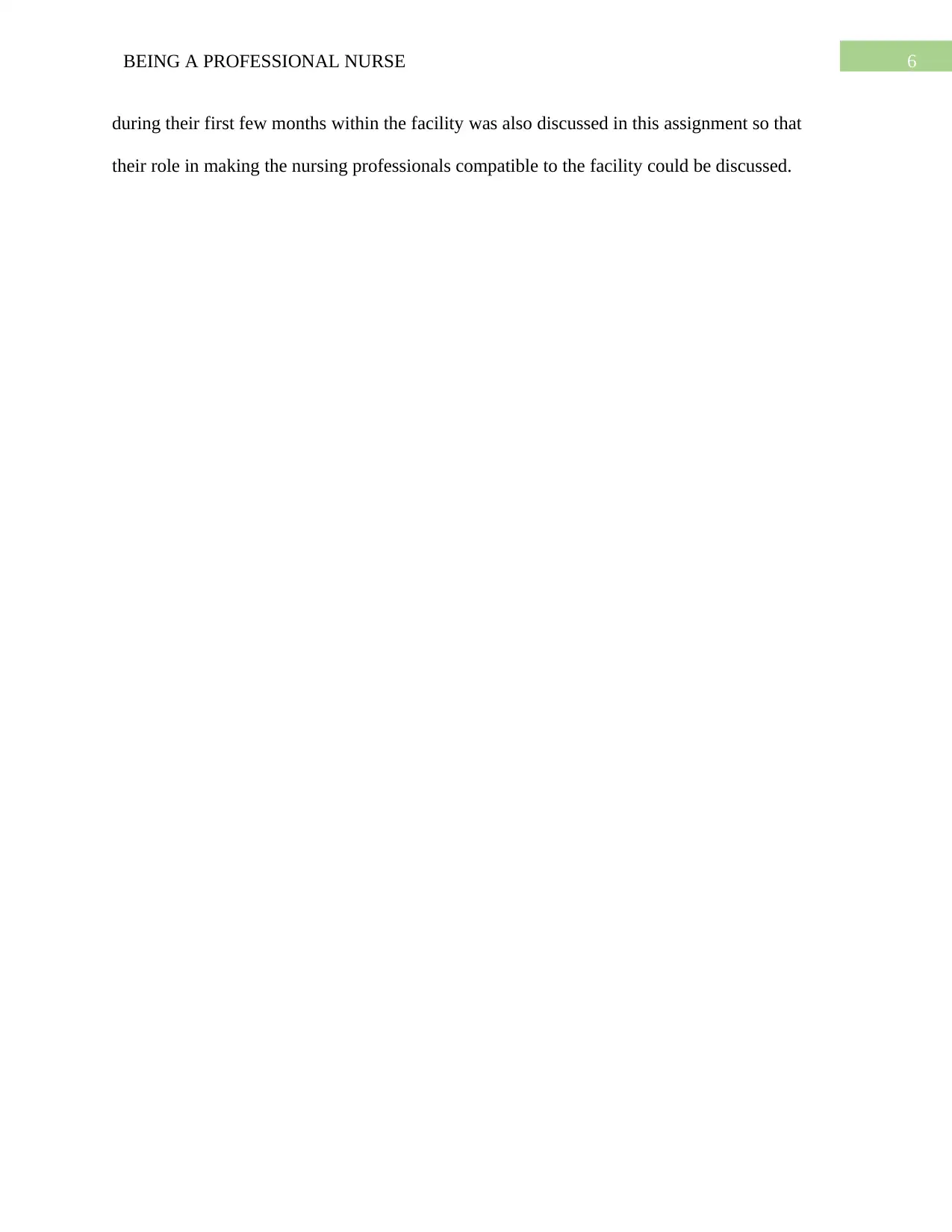
6BEING A PROFESSIONAL NURSE
during their first few months within the facility was also discussed in this assignment so that
their role in making the nursing professionals compatible to the facility could be discussed.
during their first few months within the facility was also discussed in this assignment so that
their role in making the nursing professionals compatible to the facility could be discussed.
Paraphrase This Document
Need a fresh take? Get an instant paraphrase of this document with our AI Paraphraser
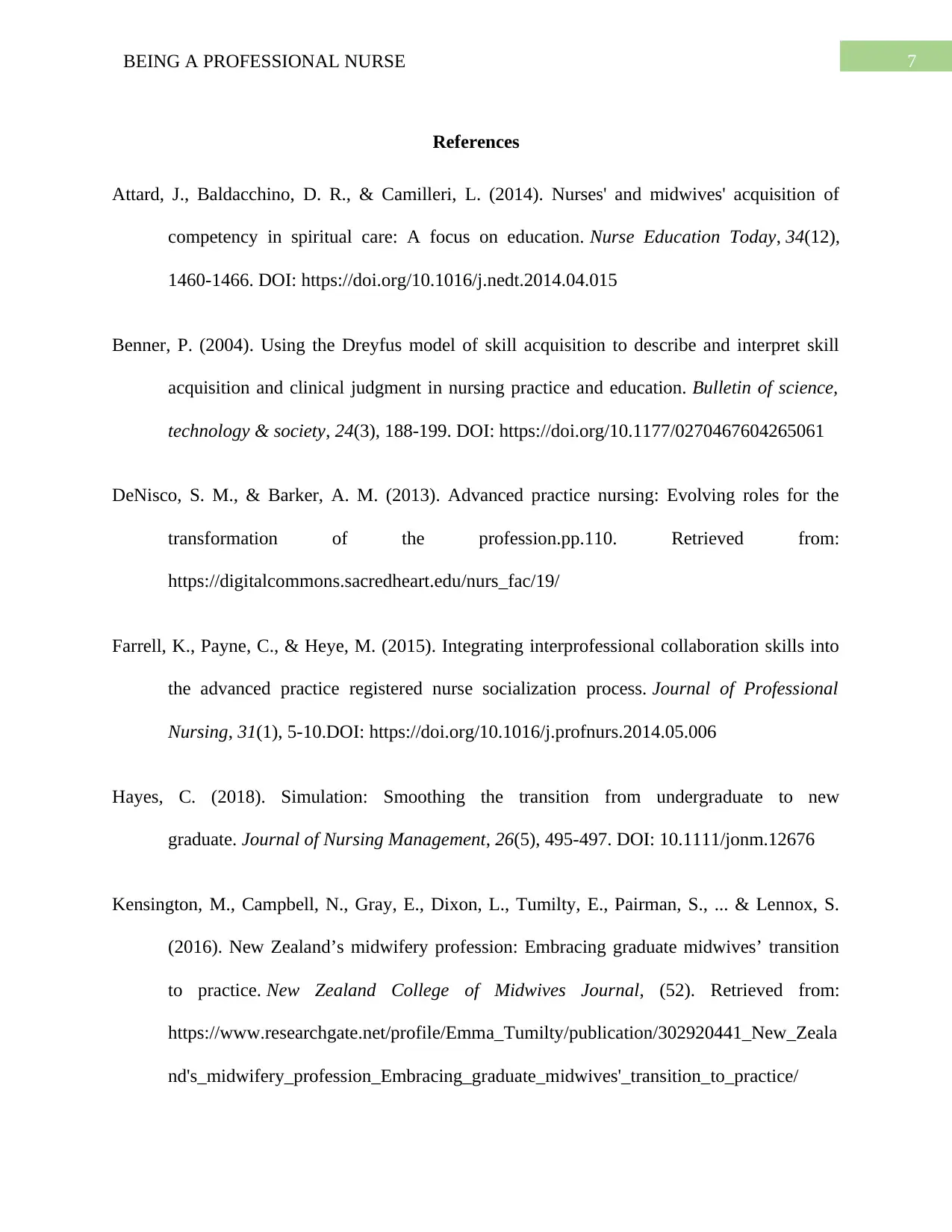
7BEING A PROFESSIONAL NURSE
References
Attard, J., Baldacchino, D. R., & Camilleri, L. (2014). Nurses' and midwives' acquisition of
competency in spiritual care: A focus on education. Nurse Education Today, 34(12),
1460-1466. DOI: https://doi.org/10.1016/j.nedt.2014.04.015
Benner, P. (2004). Using the Dreyfus model of skill acquisition to describe and interpret skill
acquisition and clinical judgment in nursing practice and education. Bulletin of science,
technology & society, 24(3), 188-199. DOI: https://doi.org/10.1177/0270467604265061
DeNisco, S. M., & Barker, A. M. (2013). Advanced practice nursing: Evolving roles for the
transformation of the profession.pp.110. Retrieved from:
https://digitalcommons.sacredheart.edu/nurs_fac/19/
Farrell, K., Payne, C., & Heye, M. (2015). Integrating interprofessional collaboration skills into
the advanced practice registered nurse socialization process. Journal of Professional
Nursing, 31(1), 5-10.DOI: https://doi.org/10.1016/j.profnurs.2014.05.006
Hayes, C. (2018). Simulation: Smoothing the transition from undergraduate to new
graduate. Journal of Nursing Management, 26(5), 495-497. DOI: 10.1111/jonm.12676
Kensington, M., Campbell, N., Gray, E., Dixon, L., Tumilty, E., Pairman, S., ... & Lennox, S.
(2016). New Zealand’s midwifery profession: Embracing graduate midwives’ transition
to practice. New Zealand College of Midwives Journal, (52). Retrieved from:
https://www.researchgate.net/profile/Emma_Tumilty/publication/302920441_New_Zeala
nd's_midwifery_profession_Embracing_graduate_midwives'_transition_to_practice/
References
Attard, J., Baldacchino, D. R., & Camilleri, L. (2014). Nurses' and midwives' acquisition of
competency in spiritual care: A focus on education. Nurse Education Today, 34(12),
1460-1466. DOI: https://doi.org/10.1016/j.nedt.2014.04.015
Benner, P. (2004). Using the Dreyfus model of skill acquisition to describe and interpret skill
acquisition and clinical judgment in nursing practice and education. Bulletin of science,
technology & society, 24(3), 188-199. DOI: https://doi.org/10.1177/0270467604265061
DeNisco, S. M., & Barker, A. M. (2013). Advanced practice nursing: Evolving roles for the
transformation of the profession.pp.110. Retrieved from:
https://digitalcommons.sacredheart.edu/nurs_fac/19/
Farrell, K., Payne, C., & Heye, M. (2015). Integrating interprofessional collaboration skills into
the advanced practice registered nurse socialization process. Journal of Professional
Nursing, 31(1), 5-10.DOI: https://doi.org/10.1016/j.profnurs.2014.05.006
Hayes, C. (2018). Simulation: Smoothing the transition from undergraduate to new
graduate. Journal of Nursing Management, 26(5), 495-497. DOI: 10.1111/jonm.12676
Kensington, M., Campbell, N., Gray, E., Dixon, L., Tumilty, E., Pairman, S., ... & Lennox, S.
(2016). New Zealand’s midwifery profession: Embracing graduate midwives’ transition
to practice. New Zealand College of Midwives Journal, (52). Retrieved from:
https://www.researchgate.net/profile/Emma_Tumilty/publication/302920441_New_Zeala
nd's_midwifery_profession_Embracing_graduate_midwives'_transition_to_practice/
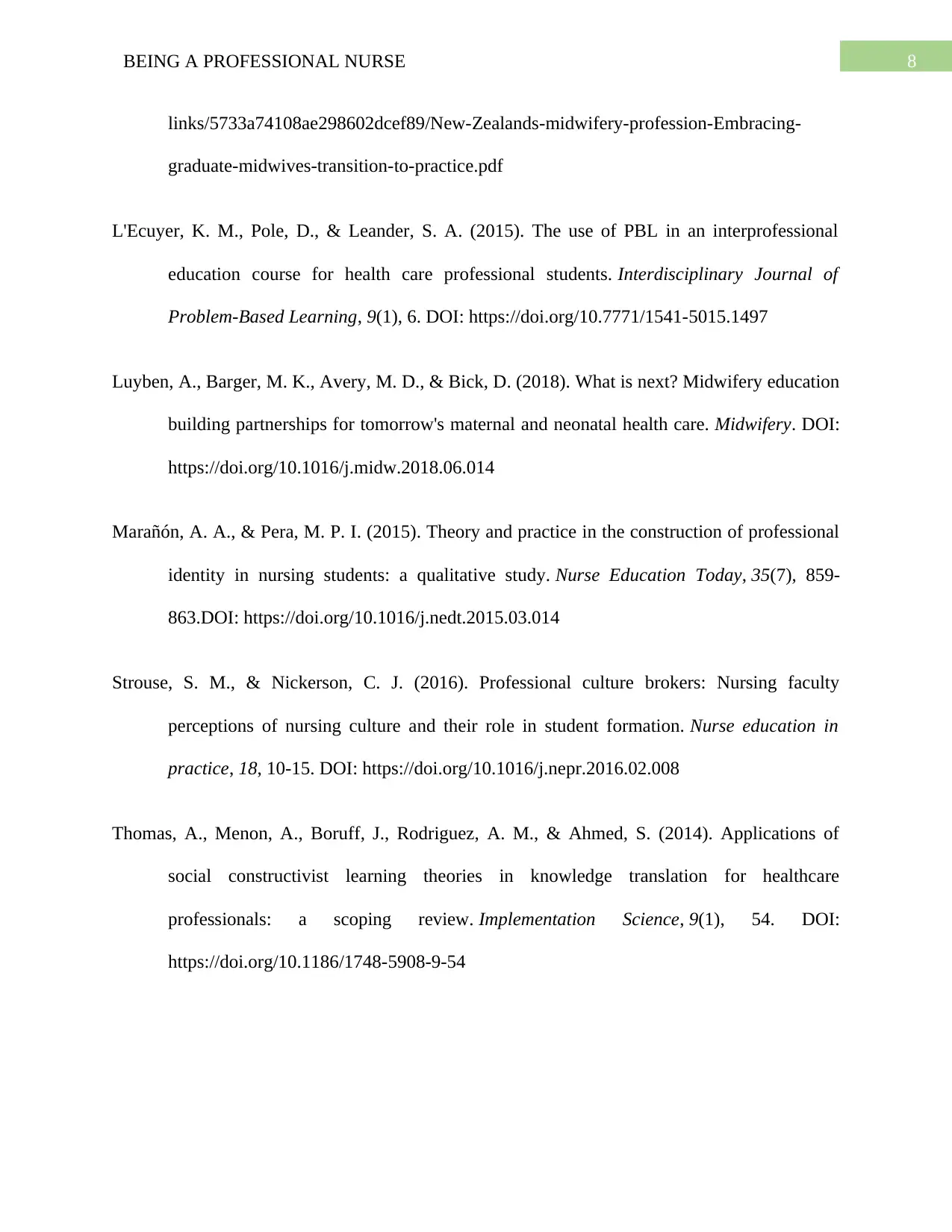
8BEING A PROFESSIONAL NURSE
links/5733a74108ae298602dcef89/New-Zealands-midwifery-profession-Embracing-
graduate-midwives-transition-to-practice.pdf
L'Ecuyer, K. M., Pole, D., & Leander, S. A. (2015). The use of PBL in an interprofessional
education course for health care professional students. Interdisciplinary Journal of
Problem-Based Learning, 9(1), 6. DOI: https://doi.org/10.7771/1541-5015.1497
Luyben, A., Barger, M. K., Avery, M. D., & Bick, D. (2018). What is next? Midwifery education
building partnerships for tomorrow's maternal and neonatal health care. Midwifery. DOI:
https://doi.org/10.1016/j.midw.2018.06.014
Marañón, A. A., & Pera, M. P. I. (2015). Theory and practice in the construction of professional
identity in nursing students: a qualitative study. Nurse Education Today, 35(7), 859-
863.DOI: https://doi.org/10.1016/j.nedt.2015.03.014
Strouse, S. M., & Nickerson, C. J. (2016). Professional culture brokers: Nursing faculty
perceptions of nursing culture and their role in student formation. Nurse education in
practice, 18, 10-15. DOI: https://doi.org/10.1016/j.nepr.2016.02.008
Thomas, A., Menon, A., Boruff, J., Rodriguez, A. M., & Ahmed, S. (2014). Applications of
social constructivist learning theories in knowledge translation for healthcare
professionals: a scoping review. Implementation Science, 9(1), 54. DOI:
https://doi.org/10.1186/1748-5908-9-54
links/5733a74108ae298602dcef89/New-Zealands-midwifery-profession-Embracing-
graduate-midwives-transition-to-practice.pdf
L'Ecuyer, K. M., Pole, D., & Leander, S. A. (2015). The use of PBL in an interprofessional
education course for health care professional students. Interdisciplinary Journal of
Problem-Based Learning, 9(1), 6. DOI: https://doi.org/10.7771/1541-5015.1497
Luyben, A., Barger, M. K., Avery, M. D., & Bick, D. (2018). What is next? Midwifery education
building partnerships for tomorrow's maternal and neonatal health care. Midwifery. DOI:
https://doi.org/10.1016/j.midw.2018.06.014
Marañón, A. A., & Pera, M. P. I. (2015). Theory and practice in the construction of professional
identity in nursing students: a qualitative study. Nurse Education Today, 35(7), 859-
863.DOI: https://doi.org/10.1016/j.nedt.2015.03.014
Strouse, S. M., & Nickerson, C. J. (2016). Professional culture brokers: Nursing faculty
perceptions of nursing culture and their role in student formation. Nurse education in
practice, 18, 10-15. DOI: https://doi.org/10.1016/j.nepr.2016.02.008
Thomas, A., Menon, A., Boruff, J., Rodriguez, A. M., & Ahmed, S. (2014). Applications of
social constructivist learning theories in knowledge translation for healthcare
professionals: a scoping review. Implementation Science, 9(1), 54. DOI:
https://doi.org/10.1186/1748-5908-9-54
⊘ This is a preview!⊘
Do you want full access?
Subscribe today to unlock all pages.

Trusted by 1+ million students worldwide
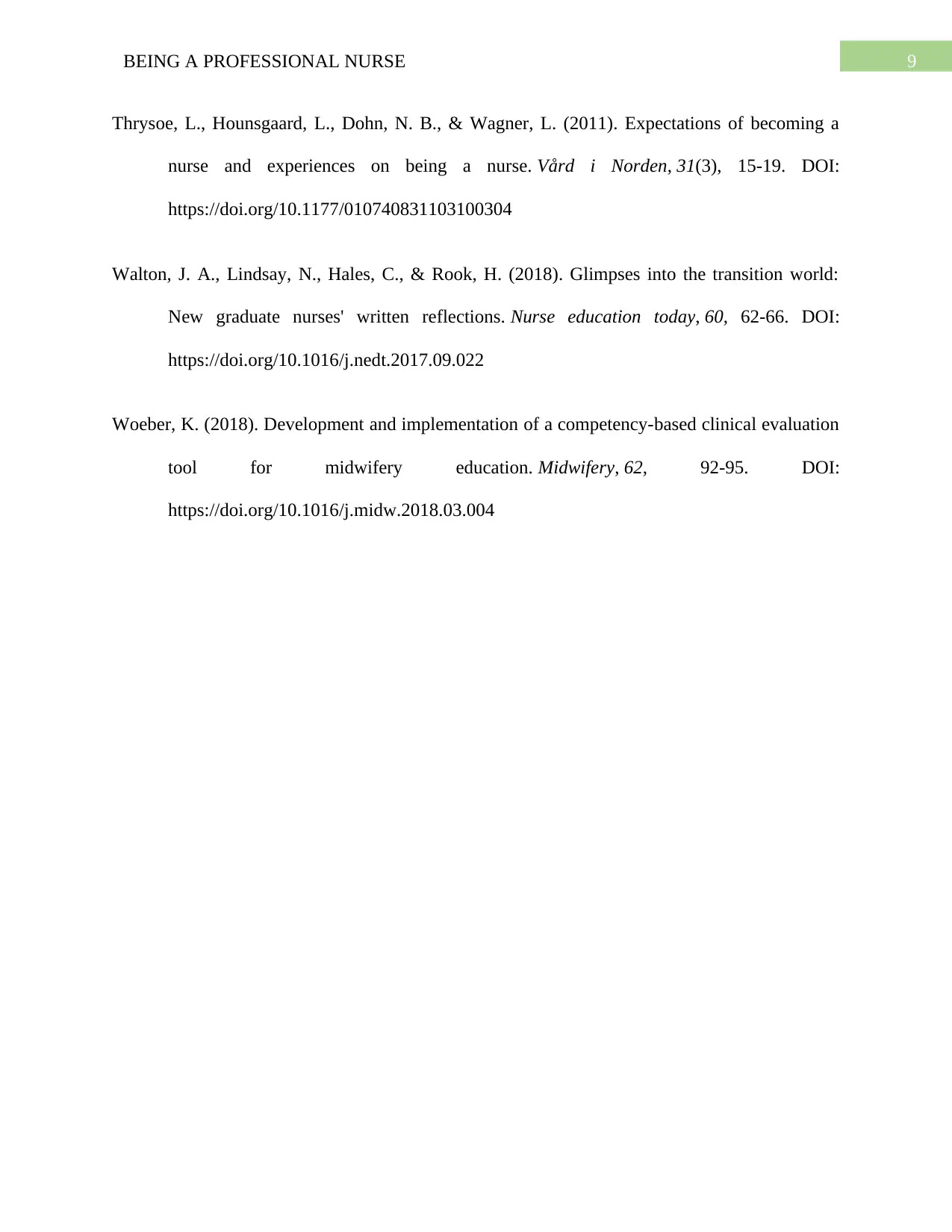
9BEING A PROFESSIONAL NURSE
Thrysoe, L., Hounsgaard, L., Dohn, N. B., & Wagner, L. (2011). Expectations of becoming a
nurse and experiences on being a nurse. Vård i Norden, 31(3), 15-19. DOI:
https://doi.org/10.1177/010740831103100304
Walton, J. A., Lindsay, N., Hales, C., & Rook, H. (2018). Glimpses into the transition world:
New graduate nurses' written reflections. Nurse education today, 60, 62-66. DOI:
https://doi.org/10.1016/j.nedt.2017.09.022
Woeber, K. (2018). Development and implementation of a competency-based clinical evaluation
tool for midwifery education. Midwifery, 62, 92-95. DOI:
https://doi.org/10.1016/j.midw.2018.03.004
Thrysoe, L., Hounsgaard, L., Dohn, N. B., & Wagner, L. (2011). Expectations of becoming a
nurse and experiences on being a nurse. Vård i Norden, 31(3), 15-19. DOI:
https://doi.org/10.1177/010740831103100304
Walton, J. A., Lindsay, N., Hales, C., & Rook, H. (2018). Glimpses into the transition world:
New graduate nurses' written reflections. Nurse education today, 60, 62-66. DOI:
https://doi.org/10.1016/j.nedt.2017.09.022
Woeber, K. (2018). Development and implementation of a competency-based clinical evaluation
tool for midwifery education. Midwifery, 62, 92-95. DOI:
https://doi.org/10.1016/j.midw.2018.03.004
1 out of 10
Related Documents
Your All-in-One AI-Powered Toolkit for Academic Success.
+13062052269
info@desklib.com
Available 24*7 on WhatsApp / Email
![[object Object]](/_next/static/media/star-bottom.7253800d.svg)
Unlock your academic potential
Copyright © 2020–2025 A2Z Services. All Rights Reserved. Developed and managed by ZUCOL.





